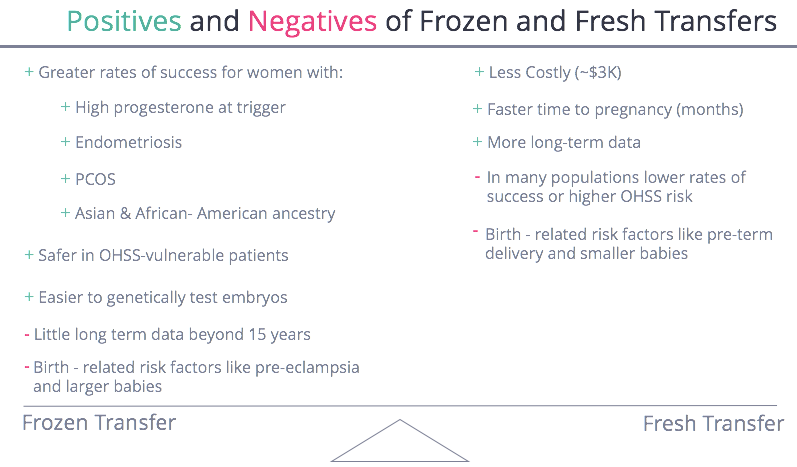Frozen Embryo Transfer Procedure
Many couples are curious about the frozen embryo transfer procedure because while the family building is desired by many, it is a complicated process. This is especially the case when there is an issue that makes natural conception difficult. Many couples usually resort to IVF in cases where natural conception proves to be elusive. While having a high chance of success, IVF also fails in some cases. In those situations, frozen embryo transfer may turn out to be a better choice.
IVF with a frozen embryo transfer has been proven to give a higher chance of a resultant live birth than even a fresh IVF process. This makes frozen embryo transfer a very popular and sought-after option for couples and doctors, especially couples who have experienced failures with multiple IVF cycles. Frozen embryo transfer also requires preparation before the transfer. This special preparation of the uterus is essential in maximizing the chances of a successful live birth from the transfer.

What is frozen embryo transfer?
Frozen embryo transfer is the transfer of a frozen stored embryo, usually from some previous IVF process. IVF processes are geared towards producing multiple embryos in order to maximize the chances of success. These extra embryos are then preserved by freezing. They are usually used by the couple for any future IVF treatments or in the case that the IVF treatment that produced the embryos fails.
Frozen embryo transfer procedure can be done without all the previous steps that normally follow in an IVF treatment. It is simply the transfer of a thawed cryopreserved embryo that was formed in a previous IVF treatment process. The uterus of the woman is prepared before the transfer in order to be accommodating to the transferred embryo. On the day of the transfer, the embryo is thawed and then transferred into the uterus. The process is shorter and less stressful than a complete IVF treatment as it bypasses numerous steps and arrives at the embryo transfer step of the IVF process.
How is the uterus prepared for the frozen embryo transfer?
The uterus is specially primed and prepared by fertility specialists. They administer the woman with medications after every three days. This is done for about two or three weeks depending on the response of the individual. The medication acts on the inner walls of the uterus (the endometrium). It helps in thickening it in preparation for the implantation of the embryo.
What are the types of uterine preparation for frozen embryo transfer?
There are two main ways of preparing the uterus for a frozen embryo transfer, they include:
- A natural support cycle – This type of preparation relies on the natural cycle of the woman. The timing of the thawing of the embryo and its transfer is estimated. The natural ovulation of the woman is taken as a marker for it. A shot of human chorionic gonadotropin is administered in order to induce the spike of estrogen which leads to ovulation. Progesterone is also administered for the luteal phase support after ovulation and embryo transfer.
- Hormonal support cycle – This is the more popular type of preparation, which is usually preferred by specialists. This is because it puts a measure of control over the entire preparation process. It makes the process easier to predict and helps them pinpoint the exact day of the transfer. In this type of preparation, estrogen and progesterone are administered to the woman to mimic the natural cycle of the body. The administration will lead to the thickening of the inner walls of the uterus. In this type of preparation, problems can also be discovered and corrected with the appropriate administration of the lacking hormone.
Are there any risks with the frozen embryo transfer procedure?
Frozen embryo transfer is preferred by specialists and most couples because it greatly reduces the risks and complications which would have been seen in the full IVF treatment process. The frozen embryo transfer bypasses a lot of the risks like the OHSS (Ovarian Hyperstimulation Syndrome) which is seen in the ovarian stimulation step. The main risk with frozen embryo transfer is that in the thawing, biopsying, and re-freezing of these embryos, they may be lost. There is also a risk that the success rate reduces when the time for its use arrives. But these risks do not make a fresh IVF process a better prospect than a frozen embryo transfer.

Is the frozen embryo transfer procedure expensive?
Ultimately, it is crucial to have a clear discussion with the healthcare provider before embarking on the process of embryo transfer. This is because there could be a variety of fees that will be associated with the treatment which may not be so obvious. The result of the discussion will go a long way in helping a couple plan and budget the treatment.
The average cost of a frozen embryo transfer is about three thousand dollars, but it may rise to about seven thousand dollars depending on the factors that are added to the costs. Some of these factors like the medication associated with the transfer will depend on the type of uterine preparation chosen by the woman. Monitoring and the transfer proper are usually pretty standard costs which may vary with the level of sophistication of the clinic. However, some costs which are not added are the initial costs of the IVF treatment, the cost of cryopreservation as well as the cost of the storage of the embryo.
Conclusion
Freezing of embryos has completely changed the process of conception and pregnancy. Couples who have an issue with infertility, and who have previously tried to conceive via multiple IVF cycles and failed now have a way of achieving their goal of family building through this process. The frozen embryo transfer process is quickly becoming a popular way of getting pregnant as more couples explore the option of completely bypassing the stress of an IVF process and jumping to the embryo transfer part. It is even possible for the couple to ship these frozen embryos internationally to another country for conception. They should make the appropriate research and discover the legality of the entire process before embarking on that journey.
The information provided in this blog is for educational purposes only and should not be considered as medical advice. It is not intended to replace professional medical consultation, diagnosis, or treatment. Always consult with a qualified healthcare provider before making any decisions regarding your health. Read more






